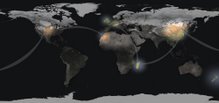It's no excuse, but a nomadic lifestyle makes it harder than I thought to keep you abreast of my activities. Yes, I know it's been a solid month since I last apprised you of the situation. Yes, I know how much ridiculously interesting stuff may or may not have happened to me during that time. I suppose I should feel guilty for having the following problem: so many flabbergastingly great things occur every day that when I consider recounting even the main points, I cower with fear. I can't tell you that it won't happen again, but I can promise that the recounting of our journey from Dunedin through Otago, the West Coast of New Zealand, the Coromandel Peninsula, the Fiji Islands, the Dark Heart of Los Angel-less, the Boise Intra-national Airport, and the endless miles of rugged semi-arid continental interior to reach this very dinosaur field camp where I am transmitting this message to you via satellite with 70 million year-old Triceratops dirt under my nails as I type, will probably be worth the wait.
For now, I'll just fill you in, dear reader, on the most recent events (not counting the harrowing denoument to the Moa story) in the largely false hope that you'll forgive me.
Eric and I caught a ride to Rudyard Montana from Bozeman just in time to join in Independence Day celebrations at the flagship field camp of the Museum of the Rockies. Bob Harmon, Chief Preparator, is a prince among men. Within sight of the Canadian border, we levered the plaster-ensconced pelvis of a duck-billed Hadrosaur onto the detached hood of a 1976 Ford, which was apparently once a handsome shade of copper. Bob, Eric, Lee, Brian and I worked to attach this improvised sled to the crane winch on the back of a Big Red Truck. The truck was 200 feet above the pelvis, which was 300 feet above the Milk River, which is zero feet from Alberta. Cables strained and stretched, dirt gave way, and 2200 lb packages of giant Cretaceous cows coasted unbelievably slowly up the American side of the gully.
Back in camp, we attempted to propel several 'freedom rockets' to the very border where we had just snached the Hadrosaur from the jaws of coherent fossil policy. Dan and Lila Redding turn incredibly vast swaths of Northern Montana into spectacular volumes of wheat. They also preserve huge unfarmable valleys and their resident dinosaurs for science. Dan likes other science projects too, and is known for his homemade fireworks. After he created a small crater and an equally cute mushroom cloud in the front yard, Eric could be heard to remark "Celebrate the independence of your nation...by blowing up a small part of it." Jack Horner pit-roasted part of a buffalo, a four-wheeler was accidentally set on fire, and I found a Theropod tooth. It was a good fourth of July.
We decided to make the drive East to Jordan and the Hell Creek on the 6th. That day was possibly the hottest day I have ever known. Trucks were packed down with every concieveable piece of gear, provisions and personnel for our subsequent mission. The A/C was on full blast, and it didn't make a bit of difference at 70 miles per hour. One-hundred six, that was the official temperature for the day. The unofficial temperature was 'damn.'
We were, however, rewarded with the first genuine milkshake of the season. Jordan, Montana has many charms, but none are so vital to survival on an igneous summer day than the classic Drugstore Malt. We learned that the coldest substance in the world can actually be created using equipment found behind the counter of a standard soda fountain four decades old. I can't tell you the trick, but I can tell you that it involves soda water, and that this miracle of science and art can readily be obtained for only $3.25. I don't have a quote for Eric because the oral muscles required to correctly utilize a straw are also needed to pronounce the words
"oh my god, shakes."
For the last three days, we've busied ourselved with another giant of the Cretaceous. At this point, digging for dinosaurs has progressed well out of the dental pick and brush stage. We're firmly in the jackhammer and pickaxe stage. Proper preparation of fossils in the field includes transporting a portion of the field back to the museum. In other words, collecting dinosaurs is less like picking flowers, more like potting a garden. The object is to present a hunk of Earth to the lab worker that contains a fossil essentially as you found it. The pickaxe and jackhammer stage lasts only one more day before entering the car hood truck-winch stage.
So for a while now, at least since Otago, we have been diggers. I suppose there are many things we could be called at this point. Most of these colorful nouns or adjectives include commentary on attitude or size. None of them have ever yet included any derivatives of the word 'clean.'
Monday, July 9, 2007
Subscribe to:
Posts (Atom)

